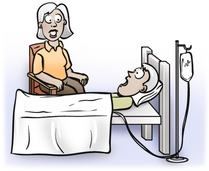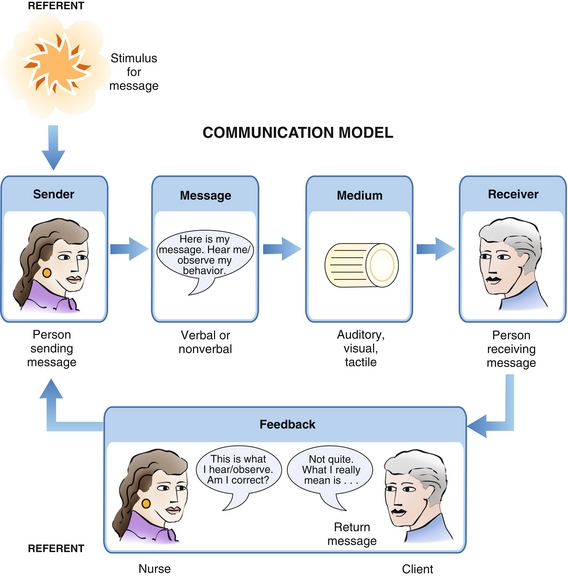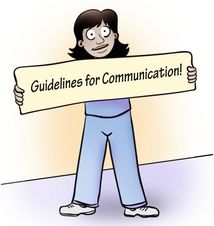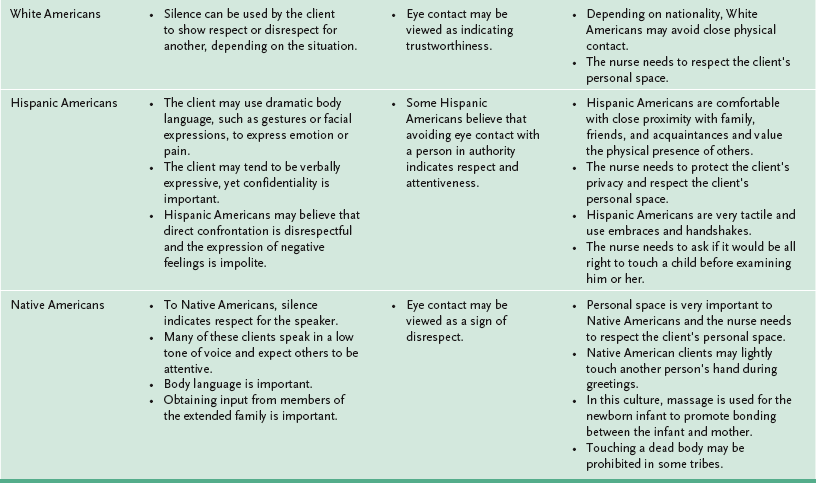Chapter 10
Communication Questions

 How Are Communication Concepts Tested in a Question?
How Are Communication Concepts Tested in a Question?

Communication model. (From Varcarolis EM: Foundations of psychiatric mental health nursing, ed 4, Philadelphia, 2002, Saunders.)
 What Guidelines Can Be Used to Answer Communication Questions?
What Guidelines Can Be Used to Answer Communication Questions?

The four primary guidelines to use when answering communication questions are as follows:
1. Use therapeutic communication techniques to answer communication questions because of their effectiveness in the communication process. As you read the question and each option, find the option that indicates the use of a therapeutic communication technique.
2. Nontherapeutic communication techniques are ineffective and should be avoided when responding to a client, a client’s family member or significant other, or another member of the health care team. As you read the question and each option, eliminate the options that indicate the use of a nontherapeutic communication technique.
3. Focus on feelings, concerns, anxieties, or fears. As you read the question and each option, look for the option that indicates the use of a therapeutic communication technique and focuses on the feelings, concerns, anxieties, or fears of the client, the client’s family member or significant other, or the health care team member.
4. Consider cultural differences as you answer the question. If you note that a question contains information that identifies a specific cultural group, think about specific cultural characteristics to answer the question correctly. Remember that each culture is unique with regard to characteristics related to the process of communication.
 Communication Techniques
Communication Techniques
What Are the Therapeutic Communication Techniques?
Therapeutic Communication Techniques
| Technique | Description |
| Active listening | Carefully noting what the client is saying and observing the client’s nonverbal behavior |
| Broad openings | Encouraging the client to select topics for discussion |
| Clarifying | Providing a means for making the message clearer, correcting any misunderstandings, and promoting mutual understanding |
| Focusing | Directing the conversation on the topic being discussed |
| Informing | Giving information to the client |
| Offering self to help | Includes staying with the client, talking to the client, and offering to help the client |
| Open-ended questions | Encouraging conversation because these questions require more than one-word answers |
| Paraphrasing | Restating in different words what the client said |
| Reflecting | Directing the client’s question or statement back to the client for consideration |
| Restating | Repeating what the client has said and directing the statement back to the client to provide the client the opportunity to agree or disagree or to clarify the message further |
| Silence | Allowing time for formulating thoughts |
| Summarizing | Stating briefly what was discussed during the conversation |
| Validating | Verifying that both the nurse and the client are interpreting the topic or message in the same way |
What Are the Nontherapeutic Communication Techniques?

Nontherapeutic Communication Techniques
| Technique | Description |
| Approval | Implying that the client is thinking or doing the right thing and is not thinking or doing what is wrong; this may direct the client to focus on thinking or behavior that pleases the nurse |
| Asking excessive questions | Demanding information from the client without respect for the client’s willingness or readiness to respond |
| Changing the subject | Avoiding addressing the client’s thoughts, feelings, or concerns; implying that the client’s statement is not important |
| Closed-ended questions | Questions that ask for specific information such as a “yes” or “no” answer and therefore inhibit communication |
| Disagreeing | Opposing the client’s thinking or opinions, implying that the client is wrong |
| Disapproving | Indicating a negative value judgment about the client’s behavior or thoughts |
| False reassurance | Making a statement that implies that the client has no reason to be worried or concerned; belittling a client’s concerns |
| Giving advice | Assuming that the client cannot think for himself or herself, which inhibits problem solving and fosters dependence |
| Minimizing the client’s feelings | Making a statement that implies that the client’s feelings are not important |
| Parroting | Repeating the client’s words before determining what the client has said |
| Placing the client’s feelings on hold | Avoiding addressing the client’s thoughts, feelings, or concerns; making a statement that places the responsibility of addressing the client’s thoughts, feelings, or concerns elsewhere or on another person |
| Value judgments | Making a comment that addresses the client’s morals; this can make the client feel angry or guilty or as though he or she is not being supported |
| “Why?” questions | Cause the client to feel defensive because many times he or she does not know the reason “why”; these types of questions also often imply criticism |






